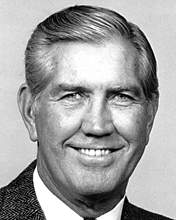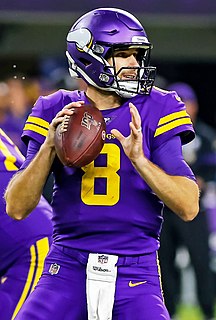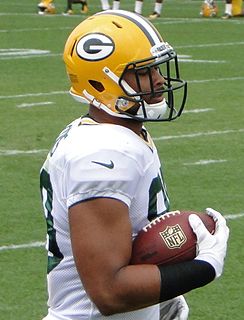Related Research Articles
The 1961 NFL season was the 42nd regular season of the National Football League (NFL). The league expanded to 14 teams with the addition of the Minnesota Vikings, after the team's owners declined to be charter members of the new American Football League. The schedule was also expanded from 12 games per team to 14 games per team where it would stay for 16 years. The Vikings were placed in the Western Conference, and the Dallas Cowboys were switched from the Western Conference to the Eastern. The addition of the Vikings returned the NFL to an even number of teams.
The 1938 NFL season was the 19th regular season of the National Football League. The season ended when the New York Giants defeated the Green Bay Packers in the NFL Championship Game.
The 1939 NFL season was the 20th regular season of the National Football League. Before the season, NFL president Joseph Carr died, and Carl Storck was named to replace him.
The 1950 NFL season was the 31st regular season of the National Football League. The merger with the All-America Football Conference (AAFC) expanded the league to 13 teams. Meanwhile, television brought a new era to the game. The Los Angeles Rams became the first NFL team to have all of its games – both home and away – televised. The Washington Redskins became the second team to put their games on TV. Other teams arranged to have selected games televised.
The 1952 NFL season was the 33rd regular season of the National Football League. Prior to the season, the legacy of the Dayton Triangles, the final remaining Ohio League member and the franchise then known as the New York Yanks owner Ted Collins sold his team back to the NFL. A few days later, a new team was then awarded to an ownership group in Dallas, Texas, after it purchased the assets of the Yanks.
The 1958 NFL season was the 39th regular season of the National Football League.
The 1950 Cleveland Browns season was the team's first in the National Football League (NFL) after playing the previous four years in the All-America Football Conference (AAFC), which folded after the 1949 season. The Browns finished the regular season with a 10–2 win–loss record and beat the Los Angeles Rams to win the NFL championship. It was Cleveland's fifth consecutive championship victory, the previous four having come in the AAFC.

Lewis Glen Carpenter was an American football player and coach. He played college football for the University of Arkansas and professionally for ten seasons in the National Football League (NFL) as a halfback and fullback with the Detroit Lions, Cleveland Browns, and Green Bay Packers. He played on three NFL Championship teams, with Detroit in 1953 and with Green Bay in 1961 and 1962. After his playing career ended, Carpenter spent 31 years as an assistant coach in the NFL with the Minnesota Vikings (1964–1966), Atlanta Falcons (1967–1968), Washington Redskins (1969), St. Louis Cardinals (1970–1972), Houston Oilers (1970–1974), Green Bay Packers (1975–1985), Detroit Lions (1987–1988), and Philadelphia Eagles (1990–1994). Carpenter also coached the Frankfurt Galaxy of the World League of American Football in 1996 and at Southwest Texas State University. He concluded his 47 years of playing and coaching football at the end of the 1996 season. Scientific tests on his brain diagnosed post-mortem that he had an advanced case of chronic traumatic encephalopathy (CTE).
Alvin Kent Nix is a former American football player who played professionally as a quarterback in the National Football League (NFL). He played college football at Texas Christian University (TCU). Nix is the son of Emery Nix, who played for the New York Giants in 1943 and 1946.
The 1953 Detroit Lions season was the franchise's 24th season in the National Football League. The Lions won their second consecutive and third overall National Football League (NFL) championship. In their fourth year under head coach Buddy Parker, the Lions compiled a 10–2 record during the regular season, outscored opponents 271 to 205, finished in first place in the NFL's Western Division, and defeated the Cleveland Browns 17–16 in the NFL Championship Game at Briggs Stadium in Detroit.
The 1952 Detroit Lions season was the franchise's 23rd season in the National Football League. The Lions won their second National Football League (NFL) championship, having won their first championship 17 years earlier in 1935. The team's co-captains were halfback Bob Hoernschemeyer and defensive tackle John Prchlik, and defensive end Jim Doran was selected as the team's most valuable player. In their third year under head coach Buddy Parker, the 1952 Lions compiled a 9–3 record during the regular season, finished in a tie with the Los Angeles Rams for first place in the NFL's National Conference, defeated the Rams in a tiebreaker game, and defeated the Cleveland Browns, 17–7, in the 1952 NFL Championship Game at Municipal Stadium in Cleveland.
The 1935 Detroit Lions season was the franchise's 6th season in the National Football League. The Lions won their first National Football League (NFL) championship. In their second season in Detroit and fifth under head coach Potsy Clark, the Lions placed first in the NFL's Western Division and went on to defeat the New York Giants, 26–7, in the 1935 NFL Championship Game. The leading offensive players were Dutch Clark, who led the NFL with 55 points, and Ernie Caddel, who led the league with 621 yards from scrimmage and 6.4 yards per touch.

Kirk Daniel Cousins is an American football quarterback for the Minnesota Vikings of the National Football League (NFL). He played college football at Michigan State and was drafted by the Washington Redskins in the fourth round of the 2012 NFL Draft as a backup to fellow rookie Robert Griffin III. Cousins occasionally appeared in games during his first three seasons before replacing Griffin following an injury in 2015, where he remained the team's starter until 2017. With the Redskins, Cousins set numerous franchise records and was named to the 2017 Pro Bowl.

Dion John Lewis is a former American football running back who played in the National Football League (NFL) for 10 seasons. He played college football at the University of Pittsburgh and was drafted by the Philadelphia Eagles in the fifth round of the 2011 NFL Draft.
This is a list of playoff records set by various teams in various categories in the National Football League during the Super Bowl Era.

Rayne Dakota Prescott is an American football quarterback for the Dallas Cowboys of the National Football League (NFL). He played college football at Mississippi State and was selected by the Cowboys in the fourth round of the 2016 NFL Draft.

Richard Christopher Rodgers II is an American football tight end for the Philadelphia Eagles of the National Football League (NFL). He played college football at California and was drafted by the Green Bay Packers in the third round of the 2014 NFL Draft. He has also been a member of the Washington Football Team and Arizona Cardinals.
References
- ↑ "Eagles upset Cleveland, 42-27". Pittsburgh Post-Gazette. Associated Press. December 14, 1953. p. 24.
- 1 2 Sell, Jack (December 28, 1953). "Lions retain NFL title; edge Browns, 17-16". Pittsburgh Post-Gazette. p. 12.
- 1 2 "Lions capture pro title 17-16". Eugene Register-Guard. (Oregon). United Press, Associated Press reports. December 28, 1953. p. 2B.
- ↑ "Cleveland Browns at Green Bay Packers - September 27th, 1953". ProFootball Reference.com. Retrieved June 23, 2021.
- ↑ "Cleveland Browns at Chicago Cardinals - October 4th, 1953". ProFootball Reference.com. Retrieved June 23, 2021.
- ↑ "Browns beat Eagles, 37-13". Eugene Register-Guard. (Oregon). United Press. October 11, 1953. p. 1C.
- ↑ "Philadelphia Eagles at Cleveland Browns - October 10th, 1953". ProFootball Reference.com. Retrieved June 23, 2021.
- ↑ "Cleveland Browns at Washington Redskins - October 18th, 1953". ProFootball Reference.com. Retrieved June 23, 2021.
- ↑ "Cleveland Browns at New York Giants - October 25th, 1953". ProFootball Reference.com. Retrieved June 23, 2021.
- ↑ "Washington Redskins at Cleveland Browns - November 1st, 1953". ProFootball Reference.com. Retrieved June 23, 2021.
- ↑ "Pittsburgh Steelers at Cleveland Browns - November 8th, 1953". ProFootball Reference.com. Retrieved June 23, 2021.
- ↑ "San Francisco 49ers at Cleveland Browns - November 15th, 1953". ProFootball Reference.com. Retrieved June 23, 2021.
- ↑ "Cleveland Browns at Pittsburgh Steelers - November 22nd, 1953". ProFootball Reference.com. Retrieved June 23, 2021.
- ↑ "Chicago Cardinals at Cleveland Browns - November 29th, 1953". ProFootball Reference.com. Retrieved June 23, 2021.
- ↑ "New York Giants at Cleveland Browns - December 6th, 1953". ProFootball Reference.com. Retrieved June 23, 2021.
- ↑ "Cleveland Browns at Philadelphia Eagles - December 13th, 1953". ProFootball Reference.com. Retrieved June 23, 2021.
- ↑ Larson, Lloyd (September 28, 1953). "Browns' machine crushes Packers under 27-0 count". Milwaukee Sentinel. p. 2, part 2.
- ↑ "Championship - Cleveland Browns at Detroit Lions - December 27th, 1953". ProFootballReference.com. Retrieved June 23, 2021.